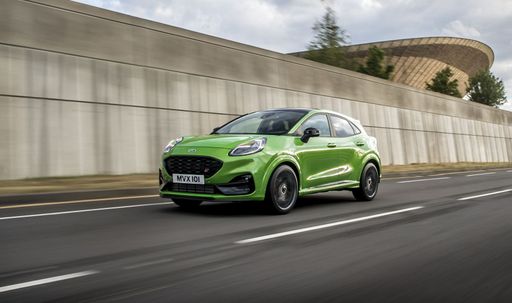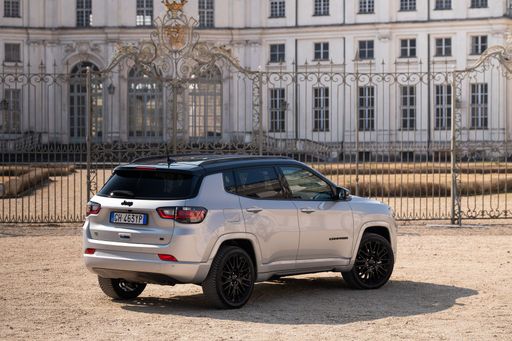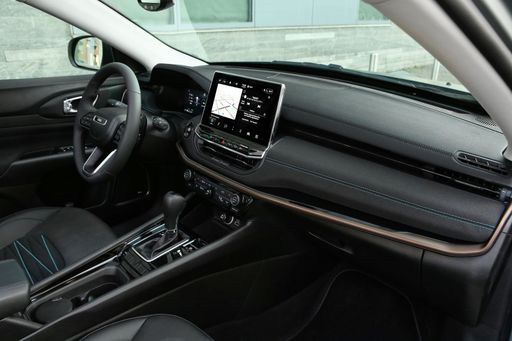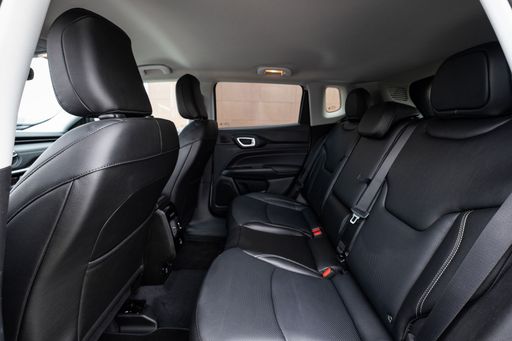When it comes to choosing the right SUV, two standout models on the market are the Ford Puma and the Jeep Compass. Both vehicles offer a blend of style, performance, and technology, but their differences cater to different driver preferences. In this article, we’ll delve into their technical specifications and innovations to help you decide which one best fits your lifestyle.
Ford Puma vs Jeep Compass – Which car suits you better?
Both models have their strengths – but which one suits you more?
Compare performance, efficiency, price and space directly: Ford Puma or Jeep Compass?
Design and Dimensions
The Ford Puma boasts a sleek and sporty design, with a length ranging from 4186 to 4226 mm, and a width of 1805 mm. Its height sits at around 1550 mm, offering a compact yet high-riding stance typical of urban SUVs.
Conversely, the Jeep Compass presents a more robust and rugged appearance. It measures 4404 mm in length and 1819 mm in width, with a taller profile at 1629 to 1649 mm. This design aligns with Jeep's adventurous heritage, making it an appealing option for those who enjoy outdoor excursions.
Engine Performance and Efficiency
The Ford Puma offers a variety of petrol and MHEV engine options with power ratings ranging from 125 to 168 HP. With a focus on efficiency, the Puma can achieve a fuel consumption figure between 5.4 and 6 L/100km, and it has an impressive electric range of up to 376 km for its MHEV variant, backed by a battery capacity of 43 kWh.
On the other hand, the Jeep Compass provides a robust lineup of engines, including petrol and plugin hybrid variants. These options give a power range from 130 HP to 240 HP, and the Compass's automatic transmission options include dual-clutch technology. Fuel consumption ranges from 2 L/100km for the hybrid to 5.5 L/100km for gasoline versions, while its electric range boasts a shorter 36 km, reflecting its hybrid nature.
Acceleration and Driving Dynamics
The Puma offers a spirited driving experience, with a 0-100 km/h acceleration time ranging from 7.4 to 9.8 seconds, depending on the engine variant. The front-wheel-drive configuration enhances agility, making it enjoyable for city driving and weekend adventures alike.
In comparison, the Jeep Compass also holds its ground in performance, achieving 0-100 km/h in as little as 7.3 seconds. The availability of an all-wheel-drive option signifies its capability for off-road situations, appealing to those who crave more rugged terrain exploration.
Interior and Cargo Space
Inside the Ford Puma, you will find a modern cabin designed with comfort in mind, comfortably seating five passengers. The trunk capacity is impressive, providing between 456 and 523 liters of space, depending on the variant—ideal for families and road trips.
Similarly, the Jeep Compass offers a spacious interior with seating for five, but it falls slightly short in cargo space—offering 420 to 438 liters. However, the Jeep is designed with versatility in mind, with multiple configurations to manage your gear.
Technological Innovations
Ford’s latest technology integrations in the Puma include advanced infotainment systems with connectivity features such as Apple CarPlay and Android Auto, ensuring drivers stay connected while on the road.
Meanwhile, the Jeep Compass showcases its off-road heritage through features like the Uconnect infotainment system, which integrates navigation, vehicle diagnostics, and more, elevating the driving experience whether on the highway or on rugged trails.
Conclusion: Which SUV Reigns Supreme?
Both the Ford Puma and the Jeep Compass present compelling options for SUV enthusiasts. The Puma excels in efficiency, sporty design, and modern tech, making it ideal for urban drivers seeking practicality and performance. Conversely, the Compass stands strong with its rugged design, off-road capabilities, and powerful engine options, catering to adventurous souls.
Ultimately, your choice will depend on your driving needs—whether you're looking for a nimble and efficient city SUV like the Puma or a robust and adventurous model like the Compass. Test driving both vehicles is recommended to find the perfect fit for your lifestyle.
Here’s where it gets real: The technical differences in detail
Costs and Efficiency:
Looking at overall running costs, both models reveal some interesting differences in everyday economy.
Ford Puma has a clearly perceptible advantage in terms of price – it starts at 24800 £, while the Jeep Compass costs 34200 £. That’s a price difference of around 9429 £.
Fuel consumption also shows a difference: Ford Puma manages with 5.40 L and is therefore barely noticeable more efficient than the Jeep Compass with 5.80 L. The difference is about 0.40 L per 100 km.
In terms of energy consumption, the advantage goes to the Ford Puma: with 13.10 kWh per 100 km, it’s evident more efficient than the Jeep Compass with 17.50 kWh. That’s a difference of about 4.40 kWh.
As for range, the Jeep Compass performs distinct better – achieving up to 500 km, about 124 km more than the Ford Puma.
Engine and Performance:
Under the bonnet, it becomes clear which model is tuned for sportiness and which one takes the lead when you hit the accelerator.
When it comes to engine power, the Jeep Compass has a evident edge – offering 213 HP compared to 168 HP. That’s roughly 45 HP more horsepower.
In acceleration from 0 to 100 km/h, the Ford Puma is slightly quicker – completing the sprint in 7.40 s, while the Jeep Compass takes 8.50 s. That’s about 1.10 s faster.
In terms of top speed, the Ford Puma performs to a small extent better – reaching 210 km/h, while the Jeep Compass tops out at 188 km/h. The difference is around 22 km/h.
There’s also a difference in torque: Jeep Compass pulls to a small extent stronger with 345 Nm compared to 290 Nm. That’s about 55 Nm difference.
Space and Everyday Use:
Cabin size, boot volume and payload all play a role in everyday practicality. Here, comfort and flexibility make the difference.
Both vehicles offer seating for 5 people.
In curb weight, Ford Puma is distinct lighter – 1316 kg compared to 1667 kg. The difference is around 351 kg.
In terms of boot space, the Jeep Compass offers hardly perceptible more room – 550 L compared to 523 L. That’s a difference of about 27 L.
In maximum load capacity, the Jeep Compass performs slightly better – up to 1561 L, which is about 278 L more than the Ford Puma.
Who comes out on top?
Overall, the Jeep Compass shows itself to be is largely superior and secures the title of DriveDuel Champion.
It convinces with the more balanced overall package and proves to be the more versatile choice for everyday use.
 @ Jeep / Stellantis Media
@ Jeep / Stellantis Media
Jeep Compass
Ford Puma
The Ford Puma is a cheeky compact crossover that blends sporty styling with city-friendly practicality, giving drivers a surprisingly fun and composed ride. With clever storage tricks and a lively personality, it’s a smart pick for buyers who want enjoyment without fuss.
details @ Ford Motor Company / Ford Media Center
@ Ford Motor Company / Ford Media Center
 @ Ford Motor Company / Ford Media Center
@ Ford Motor Company / Ford Media Center
 @ Ford Motor Company / Ford Media Center
@ Ford Motor Company / Ford Media Center
 @ Ford Motor Company / Ford Media Center
@ Ford Motor Company / Ford Media Center
Jeep Compass
The Jeep Compass packs classic Jeep styling with a surprisingly composed demeanor, equally at home turning heads in the city or tackling a weekend dirt track. Inside it's a pragmatic, user-friendly compact SUV that prioritizes comfort and versatility — a smart pick if you want a dose of adventure without giving up everyday sense.
details @ Jeep / Stellantis Media
@ Jeep / Stellantis Media
 @ Jeep / Stellantis Media
@ Jeep / Stellantis Media
 @ Jeep / Stellantis Media
@ Jeep / Stellantis Media
 @ Jeep / Stellantis Media
@ Jeep / Stellantis Media
 @ Jeep / Stellantis Media
@ Jeep / Stellantis Media
 @ Ford Motor Company / Ford Media Center
@ Ford Motor Company / Ford Media Center
|
 @ Jeep / Stellantis Media
@ Jeep / Stellantis Media
|
|
|
|
Costs and Consumption |
|
|---|---|
|
Price
24800 - 36300 £
|
Price
34200 - 43200 £
|
|
Consumption L/100km
5.4 - 5.9 L
|
Consumption L/100km
5.8 - 5.9 L
|
|
Consumption kWh/100km
13.1 - 13.9 kWh
|
Consumption kWh/100km
17.50 kWh
|
|
Electric Range
361 - 376 km
|
Electric Range
500 km
|
|
Battery Capacity
43 kWh
|
Battery Capacity
74 kWh
|
|
co2
0 - 135 g/km
|
co2
0 - 133 g/km
|
|
Fuel tank capacity
42 L
|
Fuel tank capacity
55 L
|
Dimensions and Body |
|
|---|---|
|
Body Type
SUV
|
Body Type
SUV
|
|
Seats
5
|
Seats
5
|
|
Doors
5
|
Doors
5
|
|
Curb weight
1316 - 1563 kg
|
Curb weight
1667 - 2198 kg
|
|
Trunk capacity
456 - 523 L
|
Trunk capacity
550 L
|
|
Length
4186 - 4226 mm
|
Length
4552 mm
|
|
Width
1805 mm
|
Width
1928 mm
|
|
Height
1550 - 1555 mm
|
Height
1675 mm
|
|
Max trunk capacity
1216 - 1283 L
|
Max trunk capacity
1561 L
|
|
Payload
367 - 469 kg
|
Payload
-
|
Engine and Performance |
|
|---|---|
|
Engine Type
Electric, Petrol MHEV
|
Engine Type
Petrol MHEV, Electric
|
|
Transmission
Automatic, Manuel
|
Transmission
Automatic
|
|
Transmission Detail
Reduction Gearbox, Manual Gearbox, Dual-Clutch Automatic
|
Transmission Detail
Dual-Clutch Automatic, Reduction Gearbox
|
|
Drive Type
Front-Wheel Drive
|
Drive Type
Front-Wheel Drive
|
|
Power HP
125 - 168 HP
|
Power HP
145 - 213 HP
|
|
Acceleration 0-100km/h
7.4 - 9.8 s
|
Acceleration 0-100km/h
8.5 - 10.3 s
|
|
Max Speed
160 - 210 km/h
|
Max Speed
180 - 188 km/h
|
|
Torque
170 - 290 Nm
|
Torque
230 - 345 Nm
|
|
Number of Cylinders
3
|
Number of Cylinders
3 - 4
|
|
Power kW
92 - 124 kW
|
Power kW
107 - 157 kW
|
|
Engine capacity
999 cm3
|
Engine capacity
1199 cm3
|
General |
|
|---|---|
|
Model Year
2025
|
Model Year
2025
|
|
CO2 Efficiency Class
A, D
|
CO2 Efficiency Class
D, A
|
|
Brand
Ford
|
Brand
Jeep
|
Is the Ford Puma offered with different drivetrains?
The Ford Puma is offered with Front-Wheel Drive.
The prices and data displayed are estimates based on German list prices and may vary by country. This information is not legally binding.
